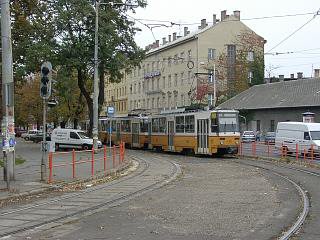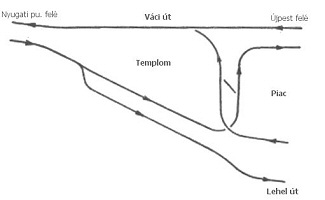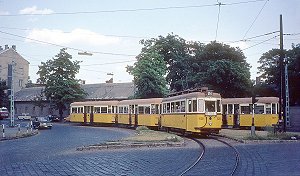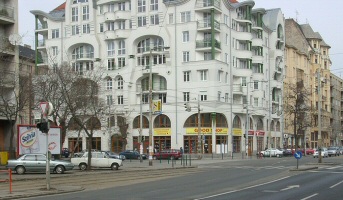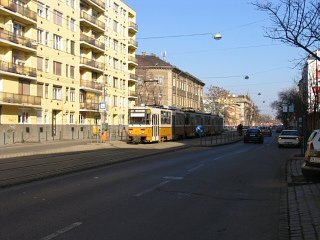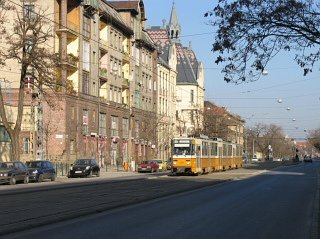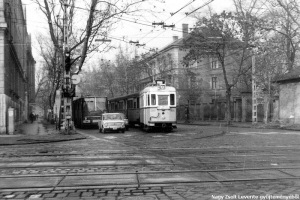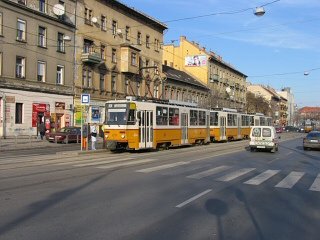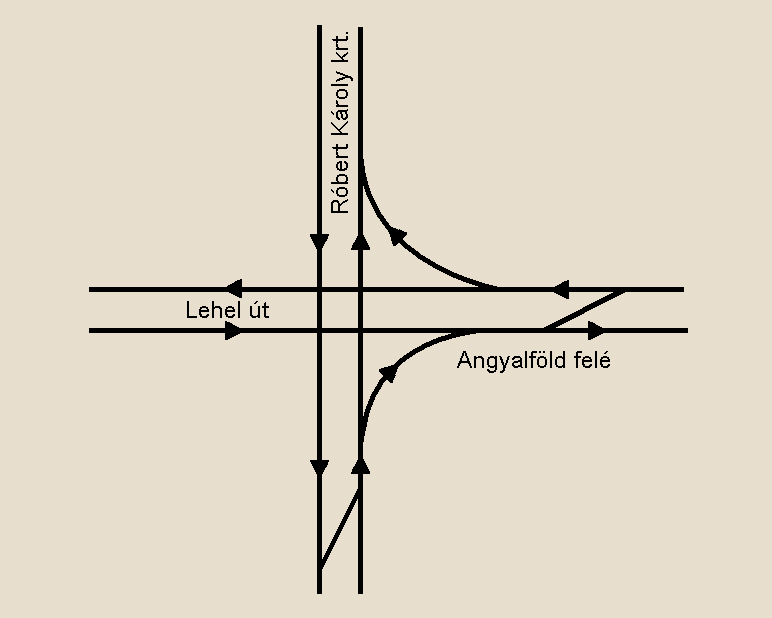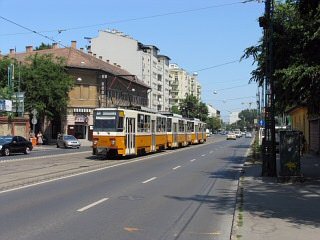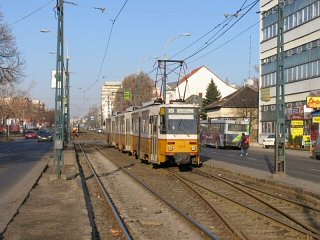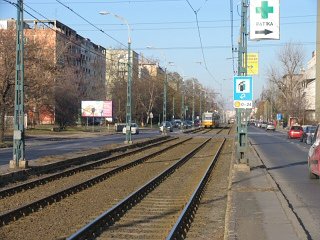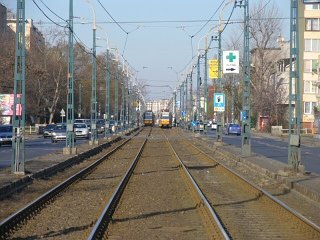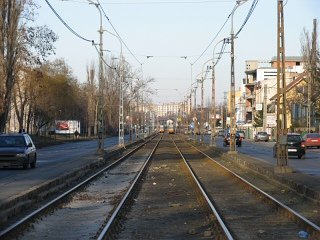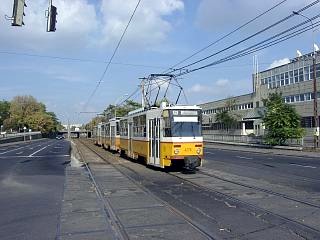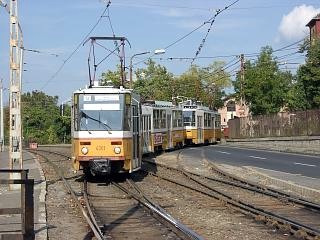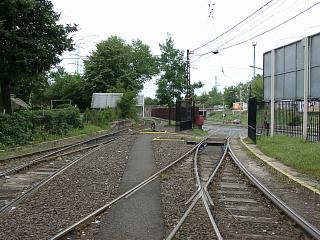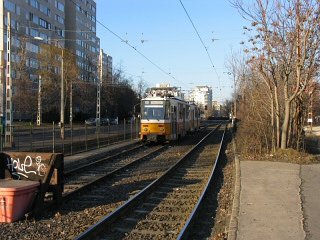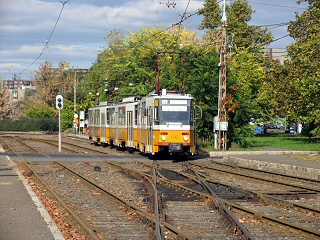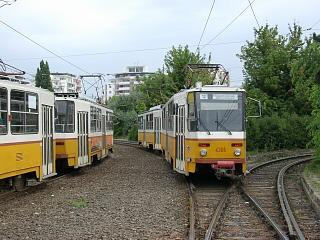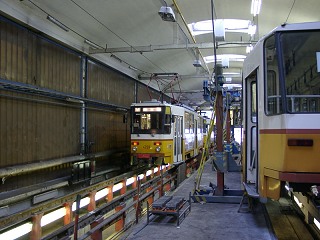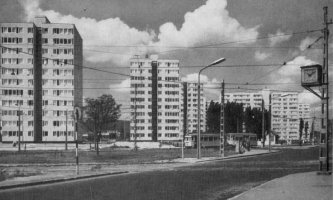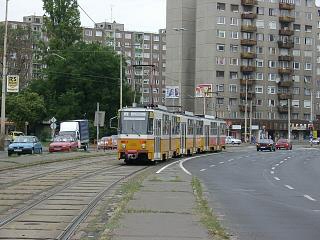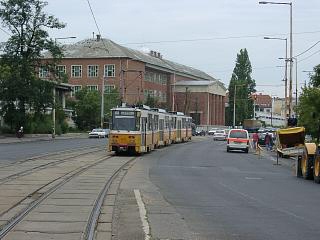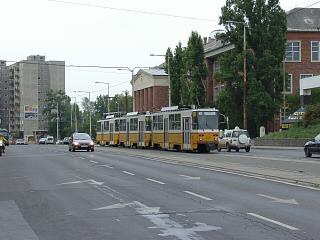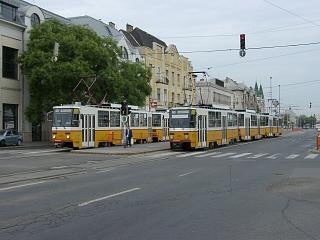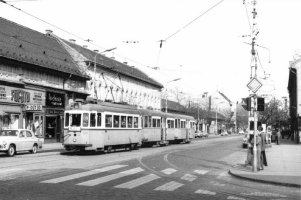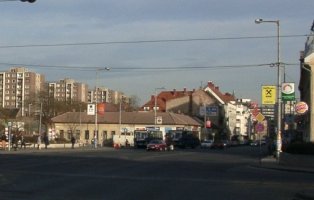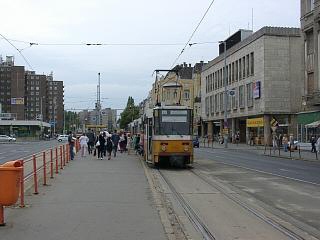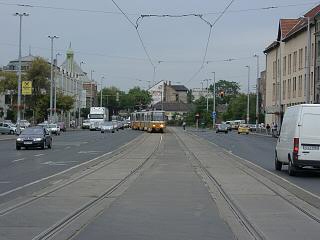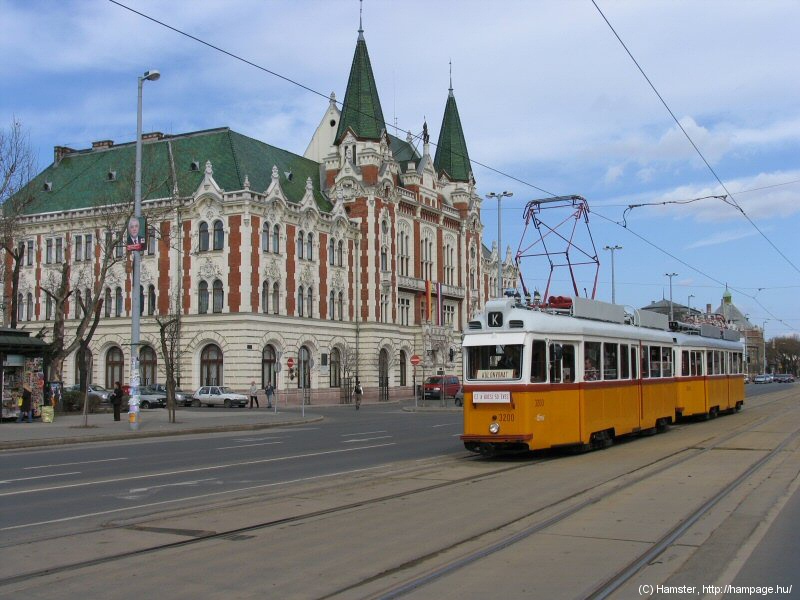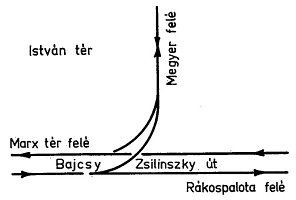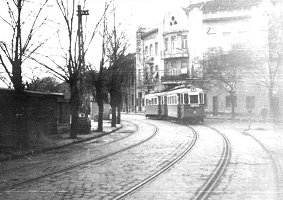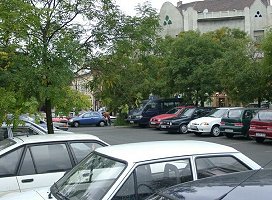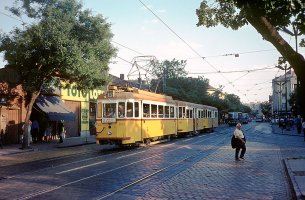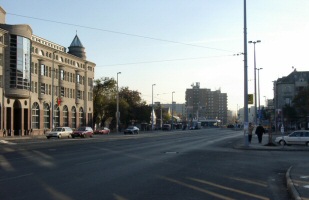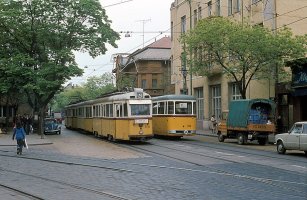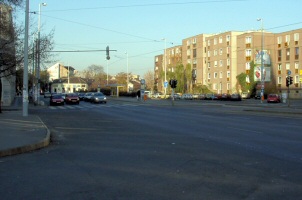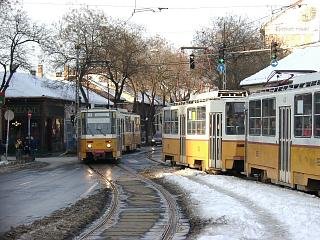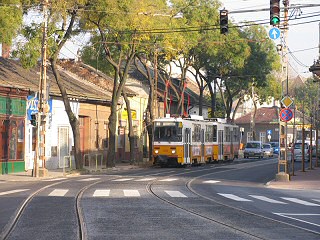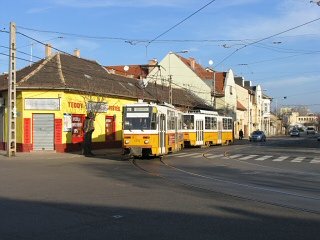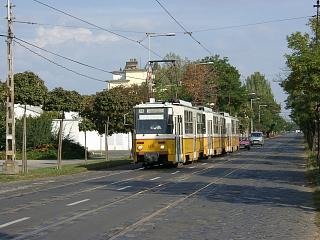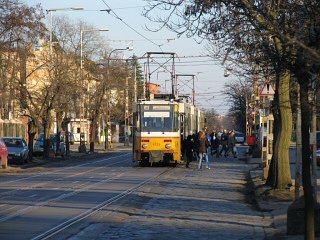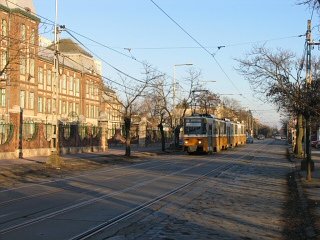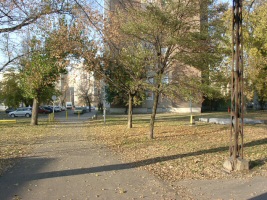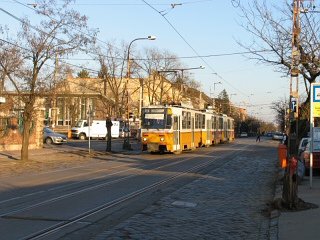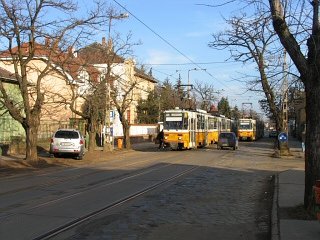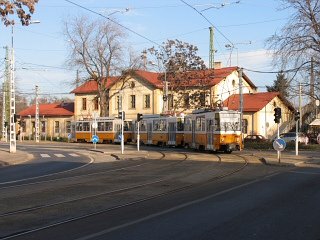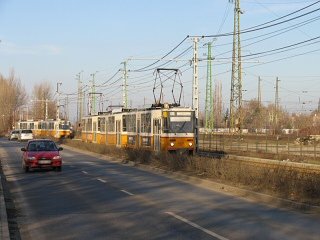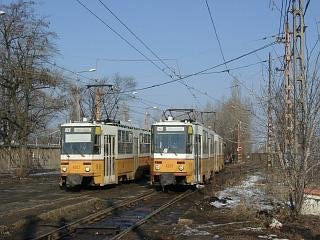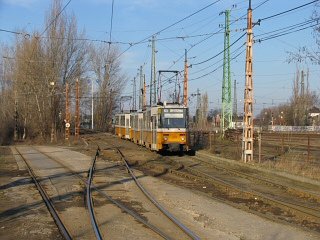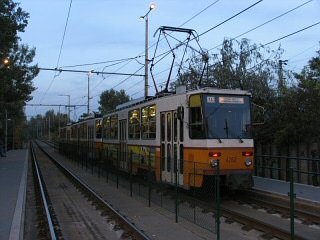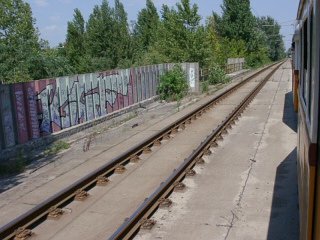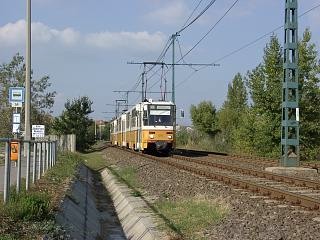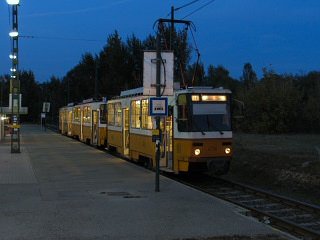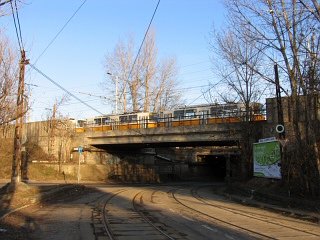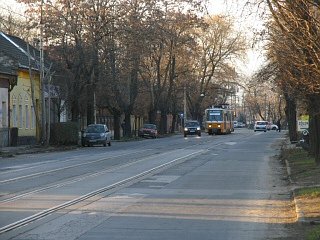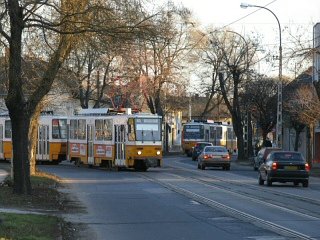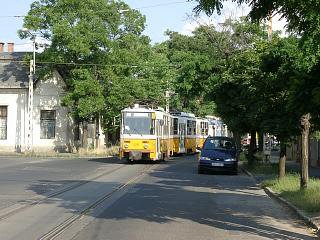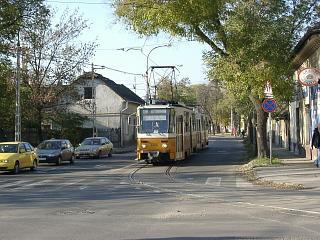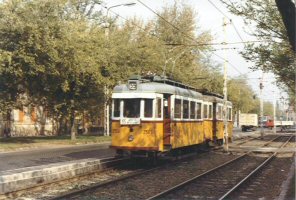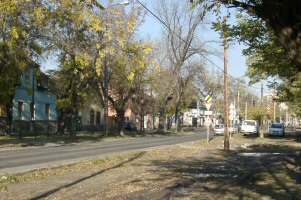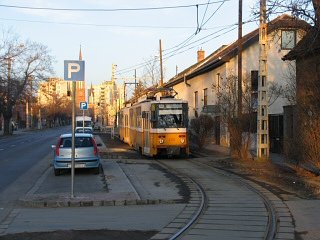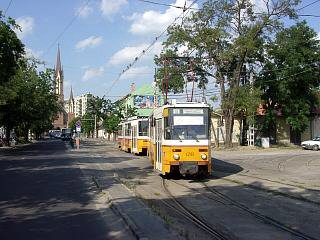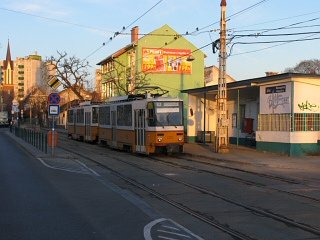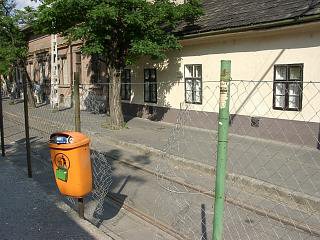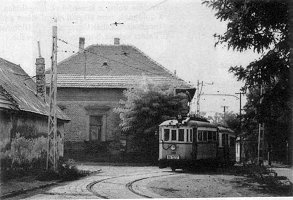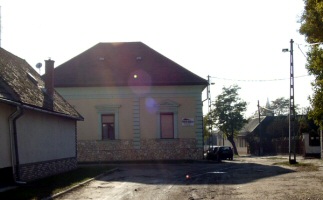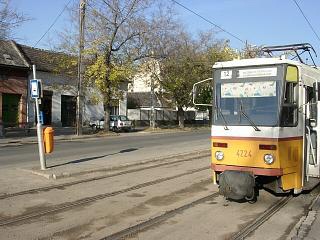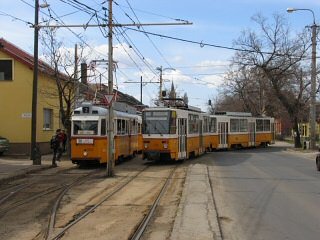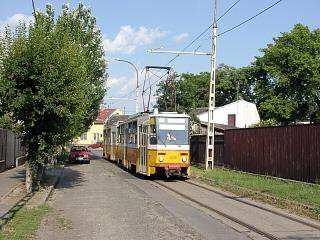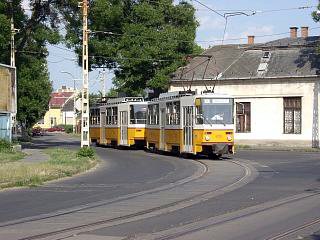Latest update: 19. March, 2016
Route 14 and 12
Route 14 is neglected by tram fans, partly because of the total lack of tourist attractions around where it runs, partly becuse it's quite long, and nothing "happens" on it for most of the ride. Indeed, this service runs through parts of the city which you would only reluctantly show to anyone (unless there is a real cause to go there). On the other hand it's a really multi-faceted tram service - especially if you're into seeing how the communist system imagined housing. To understand this comment, you must know that the districts where this tram line runs (Angyalföld (District XIII) and Újpest (District IV)), were "red" (labour) districts, thus often favoured when looking for possible sites for modern housing areas replacing old houses with minimal conveniences. While the other main street of the vicinity, Váci út was heavier on the industrial side, Lehel and Béke utca was more of a residential area, and this function got more important after World War 2 .
If you look carefully, you will see the block-houses of the 1950s, 60s, 70s and 80s in their distinct styles (all considered highly modern in their time) along the line, but from time to time this linear travel is interrupted by flashbacks of the really old days. On some streches, one side of the street sports high-rise apartment houses of the 80s, while the other still looks like a typical labour housing area of the late 19th century. If you're into such a trip through time, this line can be fun. After all, even unfortunate times are part of history.
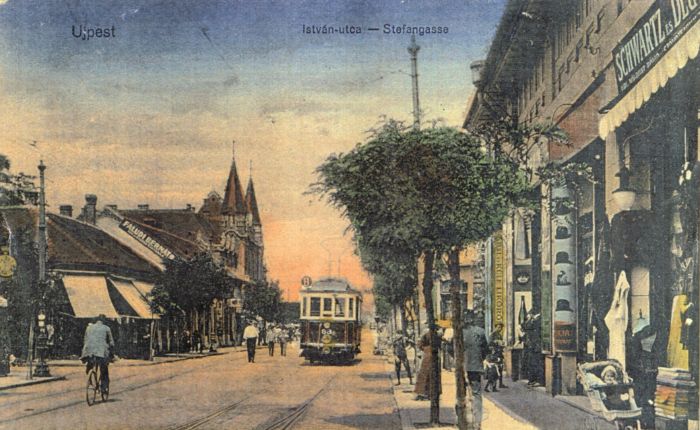
Street scene in István
út with a BURV tram. These old houses looked nice, but were small and
lacked conveniences, so they were replaced by modern, but ugly high-rise
housing areas, destroying much of the original feel of Újpest.
Route 12 is now a mere supporting service of line 14 in Újpest, but if you take a look at it historically, it used to be the main service, while route 14 was an in-lay service for decades. This was changed after the new housing areas were built in Káposztásmegyer, and especially after metro line M3 reached the center of Újpest, providing a much faster - and direct - link into the inner city. The own section of route 12 to the old center of Rákospalota (District XV.) is a real blast from the past - and therefore a living miracle! Unfortunately as of 2008, the city and the BKV plans to replace trams on weekends and in the late evening with buses, and this is likely to be the last blow to the sinking utilization of the service.
Although Újpest ("New Pest") was only a civil parish (settlement) and not a city until 1907, public transportation soon started to flourish, probably because of the proximity to Pest-Buda, and also because of the many factories along the road leading to Vác (including sites of companies like Siemens, Láng, GANZ-Danubius, Schlick&Nicholson, Tungsram), which all necessitated some means of transport between them and the homes of their workers. The first horse tram (operated by the company PKVT) of Pest ran on 30 July 1866 between today's Kálvin tér and the Újpest railway bridge. Of course the latter location was only the very brink of Újpest, so the next logical step was the launch of a horse tram service between the horse tram to Pest, the railway station of Rákospalota (then called Palota, later Palota-Újpest, currently Rákospalota-Újpest), and the center of the nearby village Rákospalota. The line opened in May 1872, and was operated by the company URLV (Újpest-Rákospalotai Lóvonatú Vaspálya Rt.). This company was later bought by the landlord of Újpest, and was then known as BVKV (Budapestvidéki Közúti Vasút Rt.). The route in question was Váci út-Árpád út-István út-Görgey Artúr út-Szilágyi utca-Pozsony utca - as we will see, this is pretty much how route 12 runs today. The Rákospalota end of the line was soon re-routed into Kertköz utca (a small street parallel to Fő utca, where route 12 now ends), where a depot was built. Frequent freight usage was a speciality of the tramway operations around here - a feature which lasted until the 1980s. Electrification came in 1897.
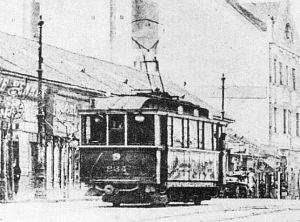
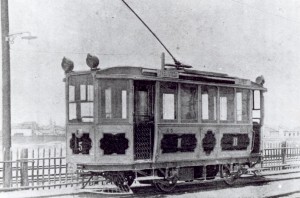
To the left: a BVKV tram
in Árpád út. To the right: an original BUR tramcar in the depot
The other tramway operator in this area was the Budapest-Újpest-Rákospalota Vasút Rt, a.k.a. BURV, better known to the people as "the BUR railway" (today's tram depot in Újpest is still called "BUR-depot" by tram folks). This company launched its service in 1896 - electrified from the start - between today's Lehel tér and Megyer, running most of the path where route 14 runs nowadays (the rest from István tér to Megyer was later known as tram line 8). In the same year they launched a branch-line to Rákospalota via Árpád út.
The inner terminus of "the BUR" was projected to be at Nyugati pályaudvar, but BKVT, the owner of the tram line in Váci út refused joint usage ("peage"). Because of this handicap, the BUR service wasn't exactly a financial success. Soon the company went almost bankrupt - and BKVT was quickly buying up the majority of their shares. After this BUR services were allowed to run to Nyugati: even though BURV was under BKVT control, they retained a formal separateness, which could be seen on their vehicles and the route designations: they used letters rather than numbers.
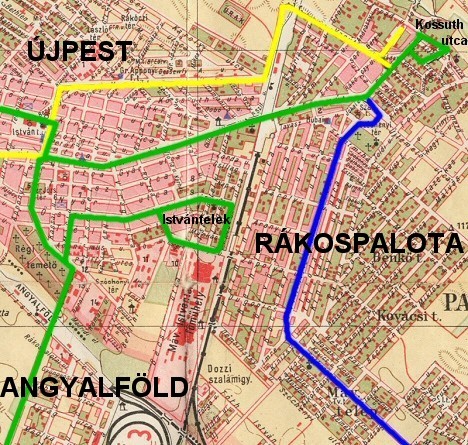
Angyalföld,
Újpest
and Rákospalota "meets" with many tram lines (sidings to factories
are not shown) in the 1920's.
Yellow line: "city" tram
(BSzKRt, formerly BVKV), green lines: BURV
services. Blue line: the vicininal line of BHÉV, later known as tram
line 65.
The "mixture" of the BURV
service coming from south, plus the "city" tram equals tram 12 and 14.
In 1938 the BUR and former BVKV routes switched ways at the crossing of Árpád út and István út (now known as the metro terminus Újpest Városközpont). From then on Váci út services went straight via Árpád út to Rákospalota, while the Lehel utca/Béke utca/Pozsonyi utca services went "straight" via István út-Görgey Artúr út-Szilágyi utca-Pozsony utca to the same terminus in Rákospalota. In the mid-80's the former path was killed off because of the metro construction works, while route 14 was even extended to the new housing area in Káposztásmegyer (1986). Unfortunately the metro construction works had a mean impact on the inner end, too: the terminus was moved back from Nyugati to Lehel tér, abolishing the direct connection with the Grand Boulevard routes. After the metro was opened in 1990, they launched a new supporting service called route 11 between Angyalföld forgalmi telep and Káposztásmegyer, but it didn't had a long life: it was abandoned in 1995. Route 12 - which was also running the full length to Lehel tér until then - was cut back to Angyalföld, forgalmi telep a week later. Route 14 received another new stretch in 1998, to the second housing area in Káposztásmegyer. Unfortunately the line ends at the brink of this second estate, which IMHO takes away a bit from its function.
Nowadays we're hoping on a restoration of the connection to Nyugati, and maybe even on a through service to Buda via the Small Boulevard (Bajcsy-Zsilinszky út + tram 47/49). This is indeed planned and talked about, but no progression is seen yet.
Here's a Google
Maps overview of the two routes:
Nagyobb
térképre váltás
Route 14: Lehel tér - Lehel utca - Béke utca - Pozsonyi utca - István út - Görgey Artúr út -Szilágyi utca - Külső Szilágyi út - Káposztármegyer, Megyeri út 10.9 km
Route 12: Angyalföld forgalmi telep - István út - Görgey Artúr út -Szilágyi utca - Pozsony utca (- Kajár utca -) - Fő út - Kossuth utca 4,6 km
Vehicles: 16 x T5C5/T5C5K
triple-set on route 14 (double-sets on weekends)
3 x T5C5/T5C5K double-set on route 12
Home depot: Angyalföld
Remark: On this page you will find a number of photos of chartered rides with vehicles other than the usual Tatras. Such rides are not exactly common here, but I thought they looked better than everyday images.
![]()
The terminus is a two-track stub one, with a scissors crossover.
There's nothing much spectacular about it. The ugly building behind it is a multi-storey market. You can also take photos of the trolley buses running on line 76 here.
Hint: The Romanesque-looking
church on the other side of the square is not a real old temple, but a
copy of the Abbey
of Ják (a real romanesque church near Szombathely).
| Lost
rails: Lehel tér - the turnout from Váci út
Lehel tér (formerly called Ferdinánd tér and then Élmunkás tér) was where the Váci út trams (originally operated by BKVT) and the Lehel utca trams (originally operated by BURV) have met/parted ways. Until 1978 this was done via the spectacular track layout depicted above. Then: this is how route 12 continued its way towards Nyugati tér in the good old days. Now: not much has changed here, only the trams have vanished... |
For about two hundred meters the tram runs
on the side of the street, then at the crossing of Bulcsú utca it
changes to the middle. On the picture above we see an inbound tram, which
leaves the middle strip as it heads for the Lehel tér terminus.
The tram has a private right-of-way in Lehel utca, but there are street crossings without traffic lights.
Taking photos here can be hard because
of the shadows cast by the buildings.
| Lost
rails: Dózsa György út
In the early 20th century, the BURV has had a service which didn't went to Nyugati, but turned onto Dózsa György út and ran to Vágány utca. Dózsa György út was also used by the trams of BVVV - most importantly by route 2/15. The section had a bit of importance in the first half of the 1950's, but was then degraded to a mere connecting status without revenue traffic. This changed at the end of 1978, when the metro construction works ouccupied Váci út between Lehel tér and Dózsa György út wholly, making the provisional tracks in Bulcsú utca unusable. Therefore the Váci út tramlines were detoured here by building a bend towards west. On the picture above we see a tram coming from Váci út via Dózsa György út, before turning onto Lehel utca towards Lehel tér. Also note the trolley bus - the tram in Dózsa György út is gone, but the trolley bus is still there. |
We go past a military depot (I suggest not to take photos there), with high-rise houses on the other side of the street. Photographing is not exactly easy here because of the strong vehicular traffic. On the picture: the stop Hun utca.
The next attraction should be the crossing of Lehel utca and Róbert károly körút, where tram 14 crosses tram 1/1A. This sounds interesting, but I was yet unable to get a clear shot of this because of the insanely strong vehicular traffic from all directions. By the way, the crossing of the tracks lays on top of a pedestrian underpass, which amplifies the sound of wheels bumping over the track grooves - quite stupid design! The connecting tracks are used by transports and depot runs of route 1/1A. Latter normaly take passengers between the stop Róbert Károly körút and Angyalföld forgalmi telep.
The last stretch of Lehel utca is changing nowadays: new apartment houses are rising where there were dull factories before. Here the sun shines from an almost perfect angle in the early afternoon.
Lehel utca ends in a sqaure called Béke tér - the name means "Peace square", and has nothing to do with the outer terminus of tram route 50, which is also called Béke tér. This is the center of Angyalföld, with the general clinic and the district's city hall. Plus there's also a church here, which is nicely illuminated in the night.
Lehel utca and Béke utca is connected with an S-shaped bend.
From here the "vicinal tramline" character gets stronger. After we cross the Rákos-patak brooklet on a small bridge, we reach the former "Ernst Thälmann Residential Area", a warren in the style of the 1950's. In case your wondering, what that means, here's a link to a photo: this is what the place looked like when it was fairly new.
There are also a few smaller housing areas around, built in different styles, and in the distance we can already see the high-rise housing areas of Újpest!
We cross the railway to Esztergom in an underpass. In fact, we're not only crossing the railway, but the whole railway station of Angyalföld. Strange, but the stairway leading to the station is located equally far from the tram stops on the two sides of the underpass. Comfortable intermodal changes were obviously not an issue when this underpass was designed.
"Forgalmi telep" is the longer form for "remise". Interestingly although this tram depo is called "Angyalföld", it is in fact located on the territory of Újpest. And to make it more bizarre: until the 1980's there was a tram depot called "Újpest" - which was located on the territory of Angyalföld! Probably that's one of the reasons why the tram folks call this place "BUR yard", even many decades after BUR was dissolved :)
The first thing we see after leaving the underpass is the rear entrance to the tram depo. Note: it is not allowed to go in there without a written permit, even if the gate is not closed!
Let's continue northwards: here we find a third, stub track between the tracks of route 14. This is the terminus of route 12, which is sometimes also used by route 14 during termporary shortenings (as on the photo on the right-hand side).
It seems space was not an issue here: the tracks for the tram lines and the ones leading to the depot are spaciously arranged, in contrast to all other BKV depots.
The depot houses around 110 Tatra
T5C5 cars and its very own snowsweeper,
number 7132. It sometimes also houses trams withdrawn from revenue traffic.
The storage yard in front of the buildings was enlarged in 2005, so there's
plenty of space there now. The depot also has a "living" (=usable) connection
to the Angyalföld railway station. If you're interested, here's
a full
track layout of the palce.
Lost
rails: the original route 14
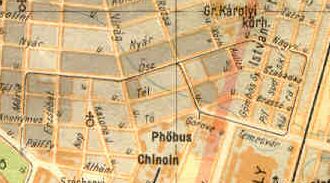 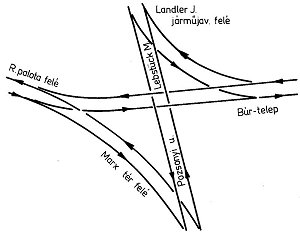
The BURV has launched a brach-line to the Istvántelek Central Workshop of the state railways on December 19 1907. The gutter-running side-line made a loop at its end. In the seventies this part of Újpest was litterally knocked down to make space for high-rise apartment houses, meaning the most of the streets where this route ran, simply vanished (although their names were reused), leaving no room for the tram. Therefore route 14 - the service that ran between Nyugati and Istvántelek - was cut back to the remise, with a reversing loop for the unidirectional Bengális. Later the line was extended to István tér, and the reversing loop was also removed. I don't have good pictures of the Istvántelek line (in fact, I only saw two photos of it until now), so instead I'll show this one, depicting the turnout of the branch-line. The tracks leading to Lebstück Mária utca can be clearly seen in the foreground of the old photo. About hundred meters of this street is still there, and some of the overhead posts are also still in place. |
From here we enter a section, where hardly any old buildings were retained - all we can see are these high-rise apartment houses.
At least the bends make the trams look a bit photogenic. The only old buildings that remained are schools (like the on the right).
István út sported the worst tram tracks in town around the new milleneum (they were probably even worse than the stretch of route 30 in Gubacsi út). Some parts were repaired a few years ago, but you can still expect a bumpy ride.
And very soon we arrive to the heart of
ol' Újpest: the crossing of Árpád út and István út.
| Lost
rails: Árpád út
As mentioned at the introduction of this page, this was where the routes of BVKV and BURV have met. In 1938 they swapped their paths, and the new situation remained until 1985, when the last Árpád út tram line - route 10 - was abandoned. Then: the crossing was a very narrow place, so only one track connection was built (left). Now the track connection is gone, just like the tram in Árpád út - and most of the old houses around (right). |
Hint: if you only want to see the outer parts of route 12 and 14, or if you don't want to ride the slowish tram back to the city, just take the metro line.
Two pictures: one looking south (left), and another, looking north (right).
The City Hall of Újpest is
a real aesthetic delight - probably the only one in this street. Only catching
a chartered tram in front of it can make it more beautiful :)
| Lost
rails: the turnout of route 8
The parking lot of the city hall was the site of another tram turnout, leading to route 8, one of the last single-track tram lines of Budapest, closed on the last day of 1980. Originally this was part of the first BURV service, later the line only ran outwards from here. Left: note the wide track grooves in the foreground - this bend was built to accomodate big-railway good waggons heading for the factories along the line. There's even an old movie, where a train towed by a steam engine arrives to this very track! Right: nothing remained of the tram here. |
To show how this area has changed, here are two "then and now" photo pairs. The old pictures were taken by Tim Boric.
You can spot the turnout to route 8 on both old photos.
Interestingly about 200 meters have still left of the old and narrow István út, so the trams switch from private right-of-way to street-running here.
This sudden change is quite remarkable, and is in my humble opinion the most interesting feature of route 14. And movie makers have discovered this: the photo on the right was made during a film shooting, when the heritage trams of the BKV and a few old cars turned the place into Budapest in the last years of the second world war!
The right-angle turn seen on the previous picture takes us into another strange street: Görgey Artúr út. The following section was rebuilt/modernised in 2014-16, but the pictures on this page still show the old look, since I had no time to take new photos since the reopening.
Here one side of the street is pretty much how it looked 100 years ago, while the other (not shown here because a/ it's ugly b/ the sun was shining in a way that it was impossible to get a good shot of it) was demolished and rebuilt with high-rise apartment houses like we already saw around Pozsonyi utca and István út.
The street is narrow, so there were no traffic
islands for the stops until 2015/16.
| Lost
rails: the Viola utca connecting line
Between 1907 and 1914 the BURV was operating a connecting service between the BVKV line running in Görgey Artúr utca, the BURV line running in Árpád út and the Istvántelek branch-line. As you can see, this line didn't last for long. As with many "lost routes" here, you cannot trace much remnants of it (because most of the streets where it ran, are gone) - apart from a very rusty overhead stanchion in a park near Árpád út. It's unbelievable that this post is still there after 90 years! |
For the last few blocks both sides of the street were retained in their original form - this can be a pleasant photo location in the afternoon!
And now comes another bend, which takes us in front of the Rákospalota-Újpest railway station.
The strech in Szilágyi utca was rebuilt in 2006...
... quite nicely. With a bit of luck you can even catch a tram with a train in the background of the photo!
Left: until the renovation of the stretch the inbound track ran in the road surface. Then the road was moved, but you can still see the asphalt between the tracks (right). And now we reached the turnout of route 12.
Or better: the turnout of route 14, because 12 came earlier.
This strech was made for the metro: the M3 line should have been built further than its current terminus at Újpest Városközpont. Plans saw it running underground until the Rákospalota-Újpest railway station, and emerging there onto the surface. The bit to the Káposztásmegyer residential area should have been running on the surface: straight ahead and fast on a physically separated permanent way, using rails anchored to concrete with resilient fixings. Unfortunately this piece of trackage hasn't been maintained ever since, so it's a bit loud (the bolts became loose), but still, trams can rush here real fast. Or at least they could: no tram is allowed to exceed the Vmax of 50 km/h in Hungary - not even on special right-of-ways...
The rest along the housing area is built in the classic way, with sleepers laid on ballast. And I guess the planners designed this stretch also with the metro in mind, because it doesn't go as close to the houses as a tram could (and should).
If the "metro strech" was strange, then so is the terminus of route 14: even though this is a line with dense headways, it has a single-track reversing spur as if it was some 20-minute service!
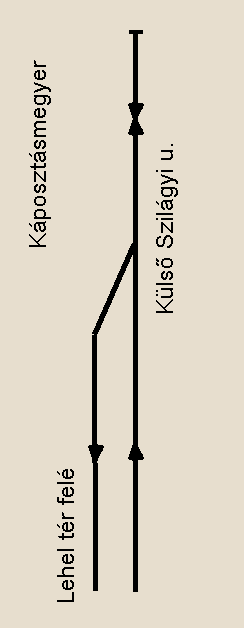
The whole thing has a very provisional feel to it, like an extension would be on the way, or something like that. But there's nothing planned.
Two pictures of the spur: one of a chartered ride (left), and one of a normal triple-set waiting for departure.
![]()
The standalone section of route 12
The own strech of route 12 is one of the last representatives of those once-typical gutter-running trams. Only this and route 30/52 has remained of their kind, and their future is everything but secured, as their utilisation is very low. To understand this phenomenon: when for example this line was built, the tram was the fastest, most modern, and for many of the locals the only way to go to the city. But nowadays private cars and buses have taken over (with a city motorway within striking distance), making a faster ride to other parts of Budapest possible - while the tram retained its long and winding path.
Although high-rise housing areas were also built around here, the streets where route 12 runs remained mostly as they were. Surprisingly the tracks are not so bad as one would expect from a neglected "vicinal" tram line...
Trams are winding down into the underpass under the state railway line on a ramp, now only used by trams.
Parts of this slope may be photographed best in different times of the day because of the position of the sun. The photos here were taken in the late evening.
Route 12 also passes under the "metro stretch" of route 14, but I haven't yet managed to get trams of both services onto the same photo. The underpass is shared by trams and cars, and has a strange "industrial" - or better: "after the nuclear winter" - tone.
Note: it's _Pozsony_ utca and not _Pozsonyi_, which we saw earlier.
It's two stops worth of street-running, after which the two directions (to the terminus and back to the city) part ways.
The bend from Pozsony utca onto
Fő
utca is a good subject for a photo - although not the easiest because
of the vehicular traffic.
| Lost
rails: Fő utca
Fő utca is where the BURV reached Rákospalota from Újpest. It was also used by the extra long vicinal tram service "H" of the company BHÉV, going from Keleti pályaudvar to Nyugati pályaudvar through the suburbs. The line was the longest tram-like line in Budapest (26 km, 95 minutes). I wrote "tram-like", because legally it was a vicinal railway, while technically it was operated with trams capable of using both 600 volts AC (as used by trams in Budapest) and 1000 volts AC (as used by the vicinal railways of Budapest). Route "H" didn't last long, it was soon replaced by tram line 69 and 65, and normal vicinal trains between Keleti pályaudvar and Rákosszentmihály. BURV - and later BSzKRt, FVV and BKV - used the Fő utca tracks henceforward. The last trams running here were route 55 until 1982, 10A until 1984 and 10 until 1985. You may still see traces of these lines, in the form of overhead posts and "suspiciously" formed sidewalks and parking places on the side of the road. |
You can still suspect where the inbound tracks of route 10/10A/55 were running: to the left of the outbound tracks of route 12. Near the terminus, the tracks of the two directions meet again.
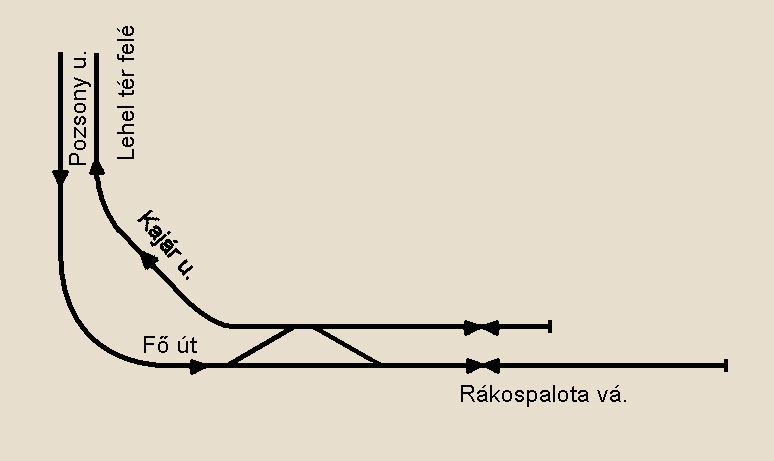
The terminus is a two-track stub one with crossovers between the two tracks.
This is a very peaceful and relaxed place - in fact so peaceful that you can hear route 14 running on the "metro stretch" about a kilometer away, or the PA of the Rákospalota-Újpest railway station. The size of the resting booth for the tram personnel gives you a hint how important this terminus once was. Apart from this, this is basically a small village with a church, and a few ugly high-rise houses behind the church - and not really a part of a town.
Hint: there are many old
houses in this street, you can recognise them from their small windows.
The oldest one - located on the now "tram-less" section
- was built in the 1700's.
When departing, trams reach Pozsony utca by turning right into...
This connection between the terminus of the BURV in Kossuth utca, and the terminus of the former BVKV line near Kertköz utca was built in 1927. This is really a must for tram photographers! After this trams turn back onto Pozsony utca, and run the same way back as hither. And this is where this page ends.
![]()
Back to the
top
Back
to the opening page
Back
to the clickable map
Disclaimer: The author cannot
be held responsible for mistakes, misinterpretations, inaccuracies, inactualities,
etc. on/of these pages, nor for the content of other pages linked in.
Archive photos: the collection
of Zoltán Ádám Németh and "Mr. Cyber", Tim Boric, Heinz Heider, Harald
Schachenhofer
Track layout drawings: Fővárosi
Villamosvasút (saját gyűjtésből), Fejes Balázs
![]()
Send
a mail to the author
The
author's homepage

